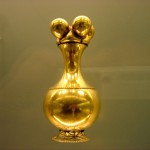The Casa de Nariño(english for House of Nariño) or Palacio de Nariño(english for Palace of Nariño) is the official home and principal workplace of the President of Colombia. It houses the main office of the executive branch and is located in the capital city of Bogotá.
The Narino Palace is Located at Carrera 7 No. 8-75, holds the offices of the National Government; this is where you find the President’s Office. The president who transferred the governmental headquarters to this palace was General Rafael Reyes, at the beginning of last century. With the name of Nariño Palace or Carrera Palace, it held the Presidential house until 1954. In 1972, the building was torn down, leaving front pieces on the Carrera 7, which still preserves traces of the former physiognomy. This is where the Yellow Hall is located, used for Official Events. This room is decorated with French furniture from the Louis XV era. As of this date and until 1979, it became the modern structure that shows today and located between the Carreras 7 and 8 and Calles 7 and 8 that hold the entrance garden, separated by the Weapon square which leads to the National Capitol.
The monumental Neo-classical building holds the lonely Astronomic Observatory tower on one side and is accompanied by a bronze statue of Antonio Nariño on front. The interiors of the Nariño Palace is decorated with colonial pieces and also from the independence era, some of them used by the liberator, Simon Bolivar and General Santander. The change of guard is carried out at 5:30 p.m. one of the most beautiful shows that can be admired in countries with military tradition.
Tours & Tickets in Bogotá Colombia
➡ Discover more about Colombia: Cali Colombia, is known by the rest Colombia as the “Rumba Capital” and by the world as the “Salsa Capital”
| BOGOTA TRAVEL GUIDE |
If you’re travelling to Bogotá Colombia, we help you:
Travel To Colombia – Tourism Website of Colombia
![]() General Information About Colombia: National symbols of Colombia – Colombia: living history – Geography of Colombia – Economy of Colombia – Languages of Colombia
General Information About Colombia: National symbols of Colombia – Colombia: living history – Geography of Colombia – Economy of Colombia – Languages of Colombia
![]() Practical information about Colombia: Climate – How to get to Colombia – Visa, Customs, Documentation and Taxes – Embassies and consulates in Colombia – Health and vaccination – Emergency numbers – Culture of Colombia – Measures and Electricity – Currency of Colombia
Practical information about Colombia: Climate – How to get to Colombia – Visa, Customs, Documentation and Taxes – Embassies and consulates in Colombia – Health and vaccination – Emergency numbers – Culture of Colombia – Measures and Electricity – Currency of Colombia
![]() Tourist Information about Colombia: General Information – Practical information about Colombia – Adventure Colombia – Hotels and accommodations in Colombia – How to Get to Colombia – Gastronomy in Colombia – Colombia’s Best Festivals and Carnivals – Tourist Attractions in Colombia – Foreign Embassies and Consulates in Colombia – Tips and advice for travel in Colombia – Top 10 Colombian Travel Destinations – Natural regions of Colombia – Cultural Tourism in Colombia – UNESCO Intangible Cultural Heritage Lists – UNESCO Heritage Sites in Colombia – Top 10 amazing places to visit in Colombia – Colombian Cuisine – Tourism of Nature
Tourist Information about Colombia: General Information – Practical information about Colombia – Adventure Colombia – Hotels and accommodations in Colombia – How to Get to Colombia – Gastronomy in Colombia – Colombia’s Best Festivals and Carnivals – Tourist Attractions in Colombia – Foreign Embassies and Consulates in Colombia – Tips and advice for travel in Colombia – Top 10 Colombian Travel Destinations – Natural regions of Colombia – Cultural Tourism in Colombia – UNESCO Intangible Cultural Heritage Lists – UNESCO Heritage Sites in Colombia – Top 10 amazing places to visit in Colombia – Colombian Cuisine – Tourism of Nature
Flights, Cheap Airfare Deals & Plane Tickets |



